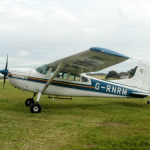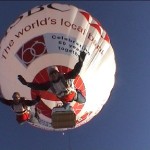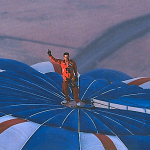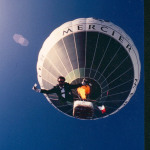 Ask any balloon pilot who has chucked a balloonist out of the basket and they will all tell you that it isn’t like it is in films. The parachutist vanishes very rapidly then gives you a heart attack as they appear to fall forever before the smudge on their back cracks into a canopy. We’ve been extremely lucky over the years having an Ian Ashpole to lob out at the slightest excuse and if we couldn’t find him then the eclectic Doddsey who landed next to me at a firework display in the pitch black, just the once, was always up for a lob as the parlance goes. For parachutists it is probably the most frightening jump they have ever made as there is no airflow such that you get when you fall out of a Skyvan at 90 knots. We spent many a happy County Show taking Royal Marines for a jump out the basket on a morning flight. It was a wonderful excuse to get up to 10,000 feet. All of them were reluctant to let go, usually backwards so they could watch the receding basket. Things were just the same when the entire Red Devils Parachute Team parachuted out of a fleet of balloons as a prelude to the Northampton Meet. Once or twice we got Ashpole to accidentally fall out of a balloon much to the consternation of the passengers but this stopped when a member of the press went hysterical. Obviously many of the stunts we used to do used parachutes as a backup and there was a second jumper with the camera but although things were a bit different then not that much has changed. Probably the one I enjoyed most was the hammock. We suspended it between two balloons the other being flown by Trish Watkins. We took off from The Chase Hotel in Ross and drifted off towards the River. It was quite wonderful, so much so that we elected, much to the consternation of a reclining Ashers, to stay quite low and follow the river at treetop height. Had the dear fellow fallen out then the parachute wouldn’t have been much use. A couple of other incidents, amongst many, including parachuting out of a mobile toilet under toilet rolls springs to mind.
Ask any balloon pilot who has chucked a balloonist out of the basket and they will all tell you that it isn’t like it is in films. The parachutist vanishes very rapidly then gives you a heart attack as they appear to fall forever before the smudge on their back cracks into a canopy. We’ve been extremely lucky over the years having an Ian Ashpole to lob out at the slightest excuse and if we couldn’t find him then the eclectic Doddsey who landed next to me at a firework display in the pitch black, just the once, was always up for a lob as the parlance goes. For parachutists it is probably the most frightening jump they have ever made as there is no airflow such that you get when you fall out of a Skyvan at 90 knots. We spent many a happy County Show taking Royal Marines for a jump out the basket on a morning flight. It was a wonderful excuse to get up to 10,000 feet. All of them were reluctant to let go, usually backwards so they could watch the receding basket. Things were just the same when the entire Red Devils Parachute Team parachuted out of a fleet of balloons as a prelude to the Northampton Meet. Once or twice we got Ashpole to accidentally fall out of a balloon much to the consternation of the passengers but this stopped when a member of the press went hysterical. Obviously many of the stunts we used to do used parachutes as a backup and there was a second jumper with the camera but although things were a bit different then not that much has changed. Probably the one I enjoyed most was the hammock. We suspended it between two balloons the other being flown by Trish Watkins. We took off from The Chase Hotel in Ross and drifted off towards the River. It was quite wonderful, so much so that we elected, much to the consternation of a reclining Ashers, to stay quite low and follow the river at treetop height. Had the dear fellow fallen out then the parachute wouldn’t have been much use. A couple of other incidents, amongst many, including parachuting out of a mobile toilet under toilet rolls springs to mind.  One such was when practising fast opening the canopy, ahead of packing and opening a paraglider canopy for something or other, by hanging onto the drogue “until you can’t hold it anymore” I did just that. The result was that the canopy was open almost instantly and I was left holding a handsome square of parachute fabric and rigging which I presented to him in the bar later enquiring what it was. I don’t recall his exact words now but he ordered a double. I have parachuted a couple of times. The first time was with the Royal Marines at Dunkeswell. I had to use the pickup to jump start the Cessna 182 tail dragger and then ended up in a feeder in a farmyard and stunk of silage for a week. Fond memories.
One such was when practising fast opening the canopy, ahead of packing and opening a paraglider canopy for something or other, by hanging onto the drogue “until you can’t hold it anymore” I did just that. The result was that the canopy was open almost instantly and I was left holding a handsome square of parachute fabric and rigging which I presented to him in the bar later enquiring what it was. I don’t recall his exact words now but he ordered a double. I have parachuted a couple of times. The first time was with the Royal Marines at Dunkeswell. I had to use the pickup to jump start the Cessna 182 tail dragger and then ended up in a feeder in a farmyard and stunk of silage for a week. Fond memories.
 Dropping parachutists is a real thrill and they love it but you do need to know what you are doing and actually take the job seriously if you are not to face a large pile of paperwork when it all goes wrong. Yes, you must make sure they have a parachute and that they have sufficient funds to buy you breakfast or a pint afterwards depending on the time of day but many pilots don’t realise that you need an Authority and you may also need a Flight Manual Supplement. Fortunately the British Parachute Association (BPA) are very sympathetic to the simplicity of balloons and the low risk factors so do not impose anything like the regulations required to be a powered aircraft drop pilot. All you need to do get the rating is contact the British Parachute Association (BPA) and apply. It is pretty straightforward as it goes and costs a paltry £20 for a two year registration and validation. You’ll need to ask for a Form 109 and read the related Form 109B and Section 9 ‘Flying’ from the BPA Manual both of which will accompany it.
Dropping parachutists is a real thrill and they love it but you do need to know what you are doing and actually take the job seriously if you are not to face a large pile of paperwork when it all goes wrong. Yes, you must make sure they have a parachute and that they have sufficient funds to buy you breakfast or a pint afterwards depending on the time of day but many pilots don’t realise that you need an Authority and you may also need a Flight Manual Supplement. Fortunately the British Parachute Association (BPA) are very sympathetic to the simplicity of balloons and the low risk factors so do not impose anything like the regulations required to be a powered aircraft drop pilot. All you need to do get the rating is contact the British Parachute Association (BPA) and apply. It is pretty straightforward as it goes and costs a paltry £20 for a two year registration and validation. You’ll need to ask for a Form 109 and read the related Form 109B and Section 9 ‘Flying’ from the BPA Manual both of which will accompany it. The application form will need to be countersigned by a BPA Category System Instructor (CSI) or a Team Leader who has previously made a balloon jump, or a balloon pilot who has already dispatched two or more parachutists from a balloon (they must have had a current rating at the time obviously). Additionally you must ensure that if there is a Flight Manual Supplement on Dropping Parachutists then it must be in your Flight Manual. That is about it really. No EASA nonsense here. However there are a few things you must bear in mind and check before letting the dare-devil plunge downwards.
The application form will need to be countersigned by a BPA Category System Instructor (CSI) or a Team Leader who has previously made a balloon jump, or a balloon pilot who has already dispatched two or more parachutists from a balloon (they must have had a current rating at the time obviously). Additionally you must ensure that if there is a Flight Manual Supplement on Dropping Parachutists then it must be in your Flight Manual. That is about it really. No EASA nonsense here. However there are a few things you must bear in mind and check before letting the dare-devil plunge downwards.
Here then is the pertinent parts of the official stuff as applied by the BPA in Section 9, Flying, of their manual which is specific to balloons. It states that; ‘A balloon pilot shall not act as Pilot-in-Command (PIC) of a Balloon for a flight during which parachutists are to be dropped unless he/she meets the following minimum requirements. That they hold a valid Pilot’s Licence for the balloon to be flown on the intended flight, that they have at least 60 hours PIC of Balloons and they have received ground instruction on parachute dropping techniques and procedures given by at least a Category System Instructor or Team Leader who has made a minimum of one parachute jump from a balloon or by a Balloon Pilot who has already dropped two or more parachutists. This must include the procedures to be followed in the event of emergencies. He/she must also have read the BPA guidelines for Skydiving from Hot Air Balloons (BPA Form 109B). Then for any parachute dropping flight, logbook evidence is required of flight within the 90 days preceding the date of the intended flight, as PIC of the Class of balloon to be used. For the privileges of a Professional Licence to be exercised on a parachute dropping flight, a Certificate of Test is also required – valid for 13 months.’
 Who can fly in the balloon is determined in section 5.7.4. Balloons; At the discretion of the operator/CI, passengers other than parachutists may be carried in balloons provided that this is in compliance with the requirements and limitations stated in the Aircraft Flight Manual and applicable Flight Manual Supplements, taking into account the purpose of the flight as deemed by the Air Navigation Order. No valuable consideration must be involved in the carriage of those passengers and that the passengers are formally informed that the flight is not being conducted in accordance with requirements of flight for the purpose of Public Transport. Additionally the balloon must be fully airworthy (obvious really) and the crew (pilot) must use oxygen during any period when the aircraft is flying above FL100. Upto and including FL130 oxygen must be used by all flight crew for that part of the flight at those FLs that is more than 30 minutes duration. During any period when the aircraft is flying above FL130 oxygen must be used by all flight crew of the aircraft.
Who can fly in the balloon is determined in section 5.7.4. Balloons; At the discretion of the operator/CI, passengers other than parachutists may be carried in balloons provided that this is in compliance with the requirements and limitations stated in the Aircraft Flight Manual and applicable Flight Manual Supplements, taking into account the purpose of the flight as deemed by the Air Navigation Order. No valuable consideration must be involved in the carriage of those passengers and that the passengers are formally informed that the flight is not being conducted in accordance with requirements of flight for the purpose of Public Transport. Additionally the balloon must be fully airworthy (obvious really) and the crew (pilot) must use oxygen during any period when the aircraft is flying above FL100. Upto and including FL130 oxygen must be used by all flight crew for that part of the flight at those FLs that is more than 30 minutes duration. During any period when the aircraft is flying above FL130 oxygen must be used by all flight crew of the aircraft.
There then are the primary points you need to take on board and now you need to take heed of the Guidelines as published by the BPA and echoed in Flight Manual Supplements. You have responsibilities to yourself and the parachutist. This is the official line as it appears in the BPA Manual. ‘Balloonists and Parachutists must comply with all the appropriate CAA and BPA rules as found in the BPA Operations Manual. It is important that the Parachutists are dropped so that they may land on a Parachute Landing Area (PLA) which is a Notified Parachute Site run by a BPA Chief Instructor holding a CAA Parachuting Permission. Or the Drop Zone is the subject of a previously submitted Parachute Display Notification applied for by a BPA Registered Parachute Display Team, the Team Leader holding the CAA Parachuting Permission’.
 Check the parachutists documents. Yes, all of them. Check that their reserve chute is in date. A packing card will confirm that the parachute has been packed within the last six months. They should be ‘B’ Licence holders. Carry out a briefing to ensure you both know and understand what is going to occur. With the basket in the upright position the jumpers should rehearse their exit. They should depart from the `cleanest’ side of the basket away from rip/dump and crown lines. If necessary rig the balloon to keep all control lines and hoses on one side. Bear in mind where your fuel lines run as they may prefer to hold onto the uprights rather than the burner frame prior to exit. As for the jump itself do not allow jumpers to depart below 2500 feet above ground level (AGL). (Note the terrain height before the drop and inform the jumpers). Explain (in simple terms) that the balloon goes with the wind so the direction at take off will be the ground wind direction. It is important for the darlings to land into wind. Do not drop jumpers near large bodies of water or concentrations of high tension power wires. Discuss the exit point (position) with jumpers and make sure everyone is happy with the spot and that they think they ought able to land on the DZ. Ensure that the Balloon is in the descent and permit only one jumper to leave at a time if it is your first flight with parachutists.
Check the parachutists documents. Yes, all of them. Check that their reserve chute is in date. A packing card will confirm that the parachute has been packed within the last six months. They should be ‘B’ Licence holders. Carry out a briefing to ensure you both know and understand what is going to occur. With the basket in the upright position the jumpers should rehearse their exit. They should depart from the `cleanest’ side of the basket away from rip/dump and crown lines. If necessary rig the balloon to keep all control lines and hoses on one side. Bear in mind where your fuel lines run as they may prefer to hold onto the uprights rather than the burner frame prior to exit. As for the jump itself do not allow jumpers to depart below 2500 feet above ground level (AGL). (Note the terrain height before the drop and inform the jumpers). Explain (in simple terms) that the balloon goes with the wind so the direction at take off will be the ground wind direction. It is important for the darlings to land into wind. Do not drop jumpers near large bodies of water or concentrations of high tension power wires. Discuss the exit point (position) with jumpers and make sure everyone is happy with the spot and that they think they ought able to land on the DZ. Ensure that the Balloon is in the descent and permit only one jumper to leave at a time if it is your first flight with parachutists.
 As for the parachutist. Expect them to ask and check your documentation. If it is their first drop from a balloon they will ensure that they fully rehearse their exit and exit order if more than one is going. This is best done with the basket rigged and them not. They love all that sort of stuff and may even spin around the basket on a skateboard to simulate the manoeuvres they will make in the freefall. The easiest way for them to leave the basket is to stand on the basket top holding on to the burner frame facing forwards or backwards as the moment takes them. Let them practice this. They will probably sing out commands like “Three, Two One. BOOGIEEEEE. They will also check the spot with the Pilot and note the height of the ground below before jumping and that they are not below 2500 feet AGL. They will only move into the jump position on your order and likewise won’t exit before your instruction. They must not deploy their parachute immediately after leaving the basket as the slow fall rate may cause the parachute to behave unpredictably. Remind them of this. It is actually the case that free-fall is the buzz for parachutists so that is seldom a problem! Whether they choose to fall out forwards or backwards is up to them but do remind them that they are falling into still air.
As for the parachutist. Expect them to ask and check your documentation. If it is their first drop from a balloon they will ensure that they fully rehearse their exit and exit order if more than one is going. This is best done with the basket rigged and them not. They love all that sort of stuff and may even spin around the basket on a skateboard to simulate the manoeuvres they will make in the freefall. The easiest way for them to leave the basket is to stand on the basket top holding on to the burner frame facing forwards or backwards as the moment takes them. Let them practice this. They will probably sing out commands like “Three, Two One. BOOGIEEEEE. They will also check the spot with the Pilot and note the height of the ground below before jumping and that they are not below 2500 feet AGL. They will only move into the jump position on your order and likewise won’t exit before your instruction. They must not deploy their parachute immediately after leaving the basket as the slow fall rate may cause the parachute to behave unpredictably. Remind them of this. It is actually the case that free-fall is the buzz for parachutists so that is seldom a problem! Whether they choose to fall out forwards or backwards is up to them but do remind them that they are falling into still air.
Parachutists like balloonists are creatures of habit and they will have their own pre-plunge checklist in the same way that you have yours but you must ensure that you understand each others needs fully and check to make sure everything is as it should be. I always ask them to check that their harness is on correctly and tight. I check that the parachute pack appears in place and that there are no signs of scuffing or damage or bits of the parachute that shouldn’t be aren’t poking out. I ask them to demonstrate where their reserve chute handle is and that they have a knife in case of a cut-away. Once they have put their parachute on don’t let them assist. Give a normal basket briefing prior to inflation as it is possible that they may not jump and will have to suffer the indignity of arriving back on the ground in the basket. I always tie all the lines up out the way once the checks are complete to minimise any risks of entanglement. Ask them to stand aside once they have their rig (parachute!) on, they do tend to get very excited around this point, and only invite them into the basket when the balloon is stable. Watch their back as they climb in to ensure nothing gets snagged. Re-iterate that they must not leave the basket until you give the command. To be honest this is probably a waste of time but its procedure. If it is an area you, or they, are not familiar with point out landmarks in the climb so they are fully aware and happy with their position before exiting. This both helps with orientation and helps them identify the wind direction should they have an off drop zone landing with no windsock. Once you give the order to prepare to jump don’t burn any more. I tend to turn off the pilot lights just to be safe and wait for the desired rate of descent. Once they’ve gone re-light and try and follow their fall and watch for the parachute. If you are in the company with another balloon dropping parachutists then it doesn’t hurt to ask what colour your chaps chute is!
in the same way that you have yours but you must ensure that you understand each others needs fully and check to make sure everything is as it should be. I always ask them to check that their harness is on correctly and tight. I check that the parachute pack appears in place and that there are no signs of scuffing or damage or bits of the parachute that shouldn’t be aren’t poking out. I ask them to demonstrate where their reserve chute handle is and that they have a knife in case of a cut-away. Once they have put their parachute on don’t let them assist. Give a normal basket briefing prior to inflation as it is possible that they may not jump and will have to suffer the indignity of arriving back on the ground in the basket. I always tie all the lines up out the way once the checks are complete to minimise any risks of entanglement. Ask them to stand aside once they have their rig (parachute!) on, they do tend to get very excited around this point, and only invite them into the basket when the balloon is stable. Watch their back as they climb in to ensure nothing gets snagged. Re-iterate that they must not leave the basket until you give the command. To be honest this is probably a waste of time but its procedure. If it is an area you, or they, are not familiar with point out landmarks in the climb so they are fully aware and happy with their position before exiting. This both helps with orientation and helps them identify the wind direction should they have an off drop zone landing with no windsock. Once you give the order to prepare to jump don’t burn any more. I tend to turn off the pilot lights just to be safe and wait for the desired rate of descent. Once they’ve gone re-light and try and follow their fall and watch for the parachute. If you are in the company with another balloon dropping parachutists then it doesn’t hurt to ask what colour your chaps chute is!
 Hot topic when it comes to dropping parachutes is the question of rates of descent when you give the order to ‘Go’. Its true that you should be in a descent, however what happens if you get it wrong. If you did your check out with Ray Bailey you will know that when he stepped out the basket on the intermediate landing so you could go solo the balloon went skywards like a home-sick angel and rounded out at 2,000 foot. Well that’s the worst that will happen if you let your parachutist leap out in the straight and level. It will be OK but you may find yourself in controlled airspace. So in an ideal world (and according to all the Manuals) you need to be going down. Take the Cameron Flight Supplement 8.29 ‘Dropping Parachutists’ as an example. They quote 200ft/min for one parachutist, 400 for two and a heady 700 for three. Ultramagic has Supplement 11 and is pretty much the same quoting 200ft/min per parachutist up to a maximum of three. Lindstrand courteously incorporate the information in their Flight Manual under 2.5.1 ‘Dropping stuff’ and recommend that no more than 30% of the balloon’s maximum weight is released at any one time and that a descent rate of approximately 500ft/min is established. If you choose to drop two, one after the other, then you must allow time for the balloon to recover and get back into a descent if it isn’t already in one. I’ve always found 200-300 ft/min is fine even for two exits.
Hot topic when it comes to dropping parachutes is the question of rates of descent when you give the order to ‘Go’. Its true that you should be in a descent, however what happens if you get it wrong. If you did your check out with Ray Bailey you will know that when he stepped out the basket on the intermediate landing so you could go solo the balloon went skywards like a home-sick angel and rounded out at 2,000 foot. Well that’s the worst that will happen if you let your parachutist leap out in the straight and level. It will be OK but you may find yourself in controlled airspace. So in an ideal world (and according to all the Manuals) you need to be going down. Take the Cameron Flight Supplement 8.29 ‘Dropping Parachutists’ as an example. They quote 200ft/min for one parachutist, 400 for two and a heady 700 for three. Ultramagic has Supplement 11 and is pretty much the same quoting 200ft/min per parachutist up to a maximum of three. Lindstrand courteously incorporate the information in their Flight Manual under 2.5.1 ‘Dropping stuff’ and recommend that no more than 30% of the balloon’s maximum weight is released at any one time and that a descent rate of approximately 500ft/min is established. If you choose to drop two, one after the other, then you must allow time for the balloon to recover and get back into a descent if it isn’t already in one. I’ve always found 200-300 ft/min is fine even for two exits.
 So there you go. Fuller information is available from the BPA and the manufacturers. Bottom line is ‘Think Safety’. I tend to fit a safety strap to myself when all this is going on, as in I tie myself to a cylinder, as there is always a surprisingly overwhelming desire to follow them out. Actually I get a similar feeling over 5000ft even on me own! Of all the parachuting exploits I’ve been involved in I have to say the one that will always stay close to me heart is one from a sunny Three Counties Showground, mid-morning. It was flat calm and I took Ian and his missis Whizz up. We went to about eight or nine grand. The crews lay on their backs and watched as we climbed out. I’d like to think they performed some sort of synchronized dry land swimming but I may have imagined that. We had an idea that we’d see how feasible it would be to get back into the basket. Ashers leapt out with the balloon in a decent descent and opened his ‘chute, we took out a gob load more and accelerated earthwards. We soon overtook him and he flew under the rather large overhang the question-marked shaped envelope had developed and suggested that as it was his missus on board we should slow down. It was certainly possible. At around 1500 feet we eventually slowed down and dropped down into a beautiful meadow on the side of the Malverns full of flowers and bathed in sunshine. We rounded out just in the top of them and drifted slowly across pretty much the whole field past a large oak tree to the gate upon which Greg and Paul were sitting. As we brushed the flowers myriads of butterflies fluttered up. It was quite the most brilliant thing.
So there you go. Fuller information is available from the BPA and the manufacturers. Bottom line is ‘Think Safety’. I tend to fit a safety strap to myself when all this is going on, as in I tie myself to a cylinder, as there is always a surprisingly overwhelming desire to follow them out. Actually I get a similar feeling over 5000ft even on me own! Of all the parachuting exploits I’ve been involved in I have to say the one that will always stay close to me heart is one from a sunny Three Counties Showground, mid-morning. It was flat calm and I took Ian and his missis Whizz up. We went to about eight or nine grand. The crews lay on their backs and watched as we climbed out. I’d like to think they performed some sort of synchronized dry land swimming but I may have imagined that. We had an idea that we’d see how feasible it would be to get back into the basket. Ashers leapt out with the balloon in a decent descent and opened his ‘chute, we took out a gob load more and accelerated earthwards. We soon overtook him and he flew under the rather large overhang the question-marked shaped envelope had developed and suggested that as it was his missus on board we should slow down. It was certainly possible. At around 1500 feet we eventually slowed down and dropped down into a beautiful meadow on the side of the Malverns full of flowers and bathed in sunshine. We rounded out just in the top of them and drifted slowly across pretty much the whole field past a large oak tree to the gate upon which Greg and Paul were sitting. As we brushed the flowers myriads of butterflies fluttered up. It was quite the most brilliant thing.
For an application form contact the BPA by email at skydive@bpa.org.uk
Flight Manual Supplements are available to download from the appropriate manufacturers’ website. Information correct at 29.01.2015.
Big ones to Ashers and Doddsey for piccies and being adventurous